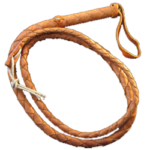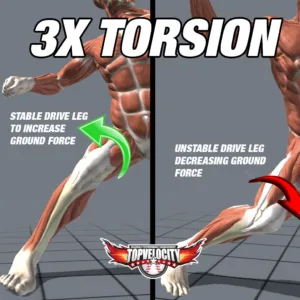 Torsion is the state of being twisted. Not mentally twisted like most pitchers but physically twisted. This is the core of 3X Pitching and this high velocity pitching component called 3X Torsion, is as good as GOLD!
Torsion is the state of being twisted. Not mentally twisted like most pitchers but physically twisted. This is the core of 3X Pitching and this high velocity pitching component called 3X Torsion, is as good as GOLD!
The big debate in the mechanics of pitching and even hitting is linear to rotation. Is it one or the other or both? 3X Pitching is the better combination of both and so much more. Torsion is what takes this revolutionary approach to pitch velocity called 3X Pitching, to not only another level but to a world of its own. This article will not only define this priceless high-velocity pitching component but will also give you some tips on how to implement it into your delivery today. The 3X Pitching Velocity Program Level 3 is the Gold Mine that uses this component to take your game to 90 plus.
 Understanding Torsion in the Pitcher
Understanding Torsion in the Pitcher
The best way to develop a good understanding of torsion is with the towel analogy. Take a towel for example and grip the towel at both ends. Now pull the towel until it is completely straight. Even though the towel is held firm it is not rigid at all. To make the towel rigid or stable you must twist the towel against itself. The tighter the torsion, the more rigid the form of the towel. The muscles in the body work the same way.
Now that you have a good understanding of how torsion can change a limber form into a rigid form the whip analogy will help define how torsion can enhance force production.  If you take several long pieces of leather and you grab one end with your hand and aggressively move the leather in a whipping motion towards a surface, the force produced from the leather will be very weak. If you take these same pieces of leather and twist them together to increase the rigidity and perform the same whipping motion the force production will be significantly increased. What we have learned is a rigid form is most powerful when enhancing force production. This same principle applies to the body of the high velocity pitcher.
If you take several long pieces of leather and you grab one end with your hand and aggressively move the leather in a whipping motion towards a surface, the force produced from the leather will be very weak. If you take these same pieces of leather and twist them together to increase the rigidity and perform the same whipping motion the force production will be significantly increased. What we have learned is a rigid form is most powerful when enhancing force production. This same principle applies to the body of the high velocity pitcher.
3X Torsion
The benefits of torsion when it comes to force production have been defined in 3X Pitching as in hip to shoulder separation and external rotation. The 3X Pitching component 3X Torsion will define mainly the drive leg but will also define the other areas of torsion throughout the entire kinetic chain of the high velocity pitcher.
Whenever the high velocity pitcher is generating force or transferring force, torsion must be present in the body to allow for an efficient and effective production and transfer of force. Ground reaction forces are produced in the legs of the high velocity pitcher. Most low velocity pitchers do not build torsion before generating ground reaction forces. This lack of rigidity or stability mainly in the lower half limits their force production which puts them in a low velocity category.
Before defining how to implement torsion in mainly the drive leg of the pitching delivery, I must first define how torsion moves through the entire body of the high velocity pitcher.
The Path of Torsion in the High Velocity Pitcher
This slow motion video of Tim Lincecum is a great model to define the path of torsion in the high velocity pitcher. In order, here are the path of torsion through the kinetic chain of the high velocity pitcher.
- Lift leg Torsion
- Landing Leg Torsion
- Separation Torsion
- External Rotation Torsion
This path of torsion in the high velocity pitcher is critical to not only generating peak forces but to transfer and multiple these force up the body. Here is each point of torsion defined in detail along with a clip from the video above to illustrate the movement.
Lift Leg Torsion
 Hips coil at leg lift which builds torsion in the drive leg by externally rotating the leg against the rubber. Notice how Tim's drive leg is externally rotating as his momentum is shifting forward. This is stabilizing the leg so it can build peak ground reaction forces as it moves down into a linear force vector position. If Tim did not build this amount of torsion in his drive leg he would reduce ground reaction forces and more than likely collapse on his drive leg going into front foot strike.
Hips coil at leg lift which builds torsion in the drive leg by externally rotating the leg against the rubber. Notice how Tim's drive leg is externally rotating as his momentum is shifting forward. This is stabilizing the leg so it can build peak ground reaction forces as it moves down into a linear force vector position. If Tim did not build this amount of torsion in his drive leg he would reduce ground reaction forces and more than likely collapse on his drive leg going into front foot strike.
I would not recommend rotating the hips as dramatic into the leg lift position as Tim is here until you have taken some baby steps with this new approach. Notice that Tim is rotating his hips into his leg lift but also at the same time he is leading with his front hip towards the target.
Landing Leg Torsion
Front leg lands as hips slam open causing the landing leg to external rotate against itself into the ground. This twisting of the landing leg as a result of hip rotation creates stability for the upper half to launch over. Low velocity pitchers have late hip rotation at front foot strike reducing the amount of torsion in the landing leg which leads to instability. Therefore more torsion in the front leg comes from early hip rotation just before front foot strike.
Separation Torsion
As the hips fire open at front foot strike the shoulders remain closed building torsion in the core. This torsion stabilizes the core which supports the transfer of energy from the lower to upper kinetic chain. This torsion also multiples the forces into shoulder rotation as it release its tension. This is the first moment in the pitching delivery when torsion is used for more than just stability.
External Rotation Torsion
Following hip to shoulder separation the shoulders launch towards the target causing the arm to externally rotate. This torsion in the throwing arm does stabilize the shoulder and elbow joints but more importantly the torsion is used to multiply forces into the acceleration of the throwing arm. This is like the end of the whip, it's job is to just delivery the blow.
Now that you have a good understanding of the path of torsion through the body of the high velocity pitcher, you can see why focusing on the torsion in the drive leg is so important. The drive leg is what initiates the delivery and where most ground reaction forces are generated. Building torsion here will create stability which gives the pitcher the potential to generate peak ground reaction forces. A loss of torsion in the drive leg will prevent this from happening. This is why the majority of low velocity pitchers have an unstable drive leg. 3X Torsion defines the importance of torsion throughout the entire body of the high velocity pitcher but more importantly the torsion in the drive leg.
Steps to Implementing 3X Torsion
Here are some steps to implementing 3X Torsion into the drive leg during the leg lift and into the "Load" position as defined in the 3X Pitching Mechanics. These steps start in the stretch position.
- Come set with the drive leg foot flush to the rubber.
- The lift leg foot should be facing in the same direction as the shoulders.
- Lift the leg up as the hips shift forward towards the target.
- Let the lift leg pull back towards the rubber as the weight shifts forward.
- Let the hips coil closed towards the target preventing the drive leg foot from moving with it. This coiling of the hips into the static drive leg will apply torsion into the leg.
- Keep the hips and drive leg in this position by accelerating the hips and the entire upper body towards the target into a linear force vector.
- Do not let the hips rotate open until after hitting a linear force vector and during triple extension of the drive leg into front foot strike.
This article should give you a good understanding of the principles of 3X Torsion and its benefits to the high velocity pitcher. The 3X Pitching Velocity Program Level 3 will use this high velocity pitcher component to help take your game to the ultimate level.


 Understanding Torsion in the Pitcher
Understanding Torsion in the Pitcher